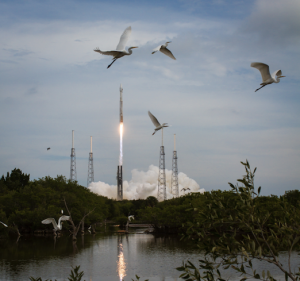
A LASP-led mission that will investigate how Mars lost its atmosphere and abundant liquid water launched into space on November 18 at 11:28 a.m. MST from Cape Canaveral Air Force Station in Florida.
The Mars Atmosphere and Volatile Evolution (MAVEN) spacecraft separated from an Atlas V Centaur rocket’s second stage 53 minutes after launch. The solar arrays deployed approximately one hour after launch and currently power the spacecraft. MAVEN now is embarking on a 10-month interplanetary cruise before arriving at Mars next September.
“MAVEN joins our orbiters and rovers already at Mars to explore yet another facet of the Red Planet and prepare for human missions there by the 2030s,” NASA Administrator Charles Bolden said. “This mission is part of an integrated and strategic exploration program that is uncovering the mysteries of the solar system and enabling us to reach farther destinations.”
As of December 10th, mission operators have successfully turned on and checked out two of eight instruments onboard the spacecraft. The NASA Goddard-built Neutral Gas and Ion Mass Spectrometer (NGIMS) was initially activated on Dec. 4, with telemetry returned as expected and spectra indicating the expected levels of noble gases. Operators checked out the LASP-built Imaging Ultraviolet Spectrograph (IUVS) on Dec. 5, and all instrument sub-systems performed as expected. As part of its checkout, the IUVS took initial measurements of interplanetary hydrogen.
Upon arrival at Mars in September, the MAVEN spacecraft will execute an orbit insertion maneuver, firing six thrusters that will allow it to be captured by Mars’ orbit. In the following five weeks, MAVEN will establish itself in an orbit where it can conduct science operations, deploy science appendages, and commission all instruments before starting its one-Earth-year scientific primary mission.
“After 10 years of developing the mission concept and then the hardware, it’s incredibly exciting to see MAVEN on its way,” said Bruce Jakosky, LASP Senior Research Scientist and MAVEN principal investigator. “But the real excitement will come in 10 months, when we go into orbit around Mars and can start getting the science results we planned.”
MAVEN is traveling to Mars to explore how the Red Planet may have lost its atmosphere over billions of years. By analyzing the planet’s upper atmosphere and measuring current rates of atmospheric loss, MAVEN scientists hope to understand how Mars transitioned from a warm, wet planet to the dry desert world we see today.
“The team overcame every challenge it encountered and still kept MAVEN on schedule and on budget,” said David Mitchell, MAVEN project manager at NASA Goddard. “The government, industry and university partnership was determined and focused to return to Mars sooner, not later.”
Watch MAVEN lift off:
[addthis]



